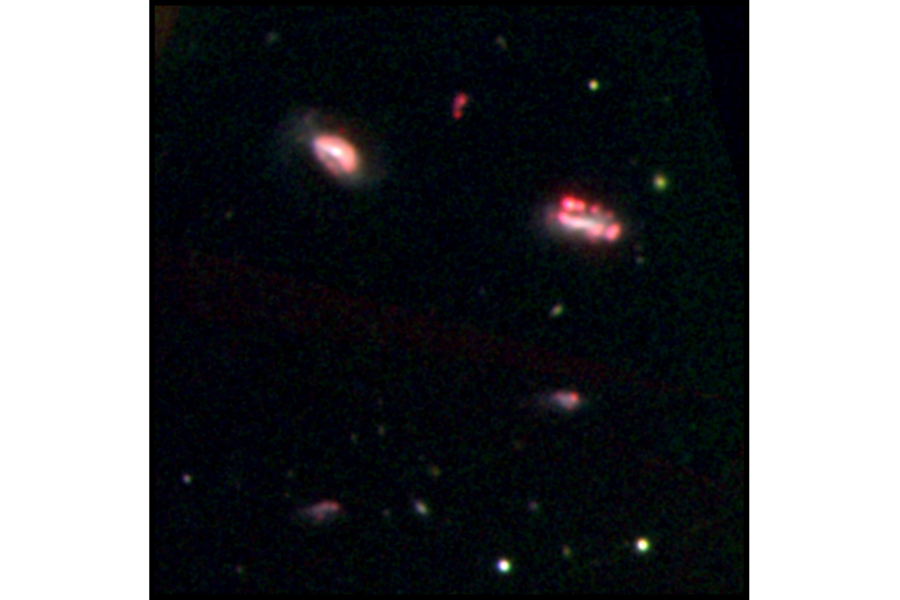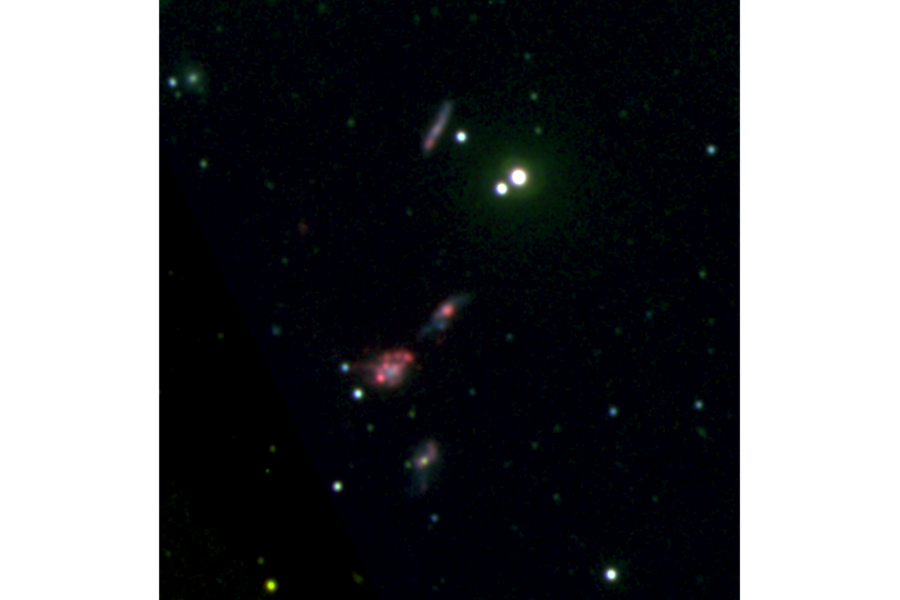How did galaxies like ours form? Elusive galaxy gangs offer clues
Loading...
Because of their small size and faint glow, groups of dwarf galaxies have long been elusive. But the detection of tightly knit groups of these little galaxies could be key to refining scientists' model to explain how the structure of the universe, and our own galaxy, formed.
Now, astronomers say they've spotted gangs of galaxies that fit that description. Their results appear in a paper published Monday in the journal Nature Astronomy.
"We're getting a snapshot of galaxy evolution in a phase that we haven't seen before," study lead author Sabrina Stierwalt, an astrophysicist at the National Radio Astronomy Observatory and the University of Virginia, tells The Christian Science Monitor in a phone interview. "My group found one of the clearest examples of evidence to back up this theory of how structure formed."
Scientists generally agree on a model, the Lambda cold dark matter (ΛCDM) paradigm, to explain how the universe came to have the structure observed today. Put simply, the idea is that gravity pulls smaller things together to merge and form larger structures. For example, a medium-sized galaxy like the Milky Way galaxy that we live in would have been born when multiple less massive galaxies, dwarf galaxies, were drawn together into a group and then eventually smashed together.
For galaxies, that process, called hierarchical assembly, would happen over a couple billions of years as dwarf galaxies were drawn together by each others' gravity.
On those sorts of timescales, a single generation of human scientists would be unable to watch such a galactic merger. Instead, astronomers have to look out at the universe as a sort of snapshot.
Researchers have spotted several other clues that support the ΛCDM model, but they had yet to spot groups of dwarf galaxies on the verge of merging.
So Dr. Stierwalt and her colleagues went hunting for dwarf galaxy groups in the Sloan Digital Sky Survey data.
First the researchers used an algorithm to identify pairs of dwarf galaxies. Then they looked at the pairs themselves to see if there was any evidence that they were more than a pair (a group in astronomy, Stierwalt says, is more than two). To confirm these detections and make sure that the little galaxies were actually grouped together and didn't just look like they were neighbors, the team used the Magellan Telescope in Chile to take a closer look.
In the end, the researchers identified seven groups of dwarf galaxies that fit the bill.
To be counted as strong support of hierarchical assembly in action, a group had to do more than include at least three galaxies that were 10 to 1,000 times smaller than our own Milky Way galaxy. The group also had to be isolated from other galactic structures and show clear evidence that the galaxies were gravitationally bound.
The dwarf galaxies have to be isolated, explains Kristen McQuinn, an astrophysicist at the University of Texas at Austin who was not involved in the study, because if they are near a larger galaxy (perhaps like the many dwarf galaxies that are satellites to the Milky Way) "it doesn't necessarily mean that we're witnessing hierarchical assembly."
"It could just be that the gravity of a massive galaxy has pulled these smaller galaxies in more recently, but originally formed via another mechanism," she tells the Monitor.
Another key feature of the model of hierarchical assembly of dwarf galaxies is that they are gravitationally bound to each other, being pulled together by each others' gravity. Groups of dwarf galaxies have been spotted before, Dr. McQuinn says, but because the galaxies were loosely associated, it was ambiguous as to whether the dwarf galaxies were actually in the process of merging.
But for the seven identified by Stierwalt and her team, that is not the case. And, McQuinn says, "that's one of the things that makes their result unique."
"It's very hard to prove that a group of galaxies definitively is gravitationally bound to each other," Stierwalt says. But the team looked at how much mass the groups of dwarf galaxies had and how fast they are moving relative to each other, and determined that the dwarf galaxies in these seven groups have characteristics consistent with being gravitationally bound.
Julio Navarro, an astrophysicist at the University of Victoria in Canada who was not involved in the research, says the discovery is not all that surprising. "I’d say that the results are indeed consistent with what was expected from Lambda CDM, so no surprises there," he writes in an email to the Monitor. "After all, most other galaxies are in groups, so why not dwarfs?"
But, he says, "The interest of the paper, in my opinion, is in providing a first step towards building a proper inventory of these systems."
Groups of dwarf galaxies are predicted to be quite rare in the ΛCDM model and have been difficult to detect until now.
McQuinn agrees that this detection won't change much for researchers working to understand the structure of the universe. "If the contrary had been proven, it would have been a bigger deal" for the model, she says, particularly because there is already a lot of support for the ΛCDM paradigm in other ways. The new detection matches the predictions of all the characteristics expected for isolated groups of dwarf galaxies in the process of hierarchical assembly.
"It predicts things on large scales very well, but sometimes it has trouble with predicting things on smaller scales," Stierwalt says of the ΛCDM paradigm. And because of that, researchers are largely focusing on making observations to fine-tune the theory. "My goal is to poke at the theory until I find where it doesn't work. And so far it's working pretty well."









